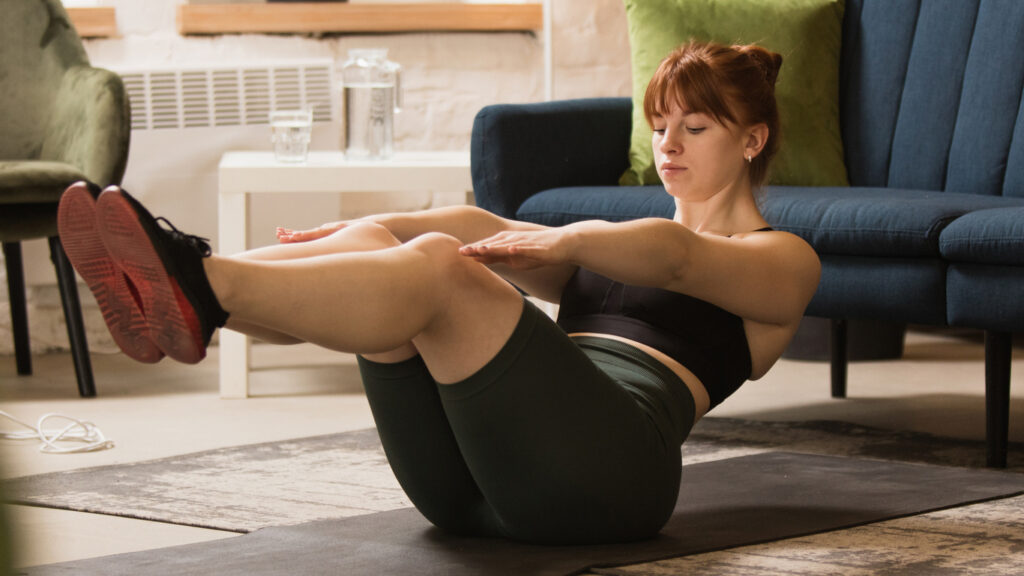
ABS workout. Young woman exercising fitness, aerobic, yoga at home, sporty lifestyle and home gym. Getting active during lockdown, quarantine. Healthcare, movement, wellness and action concept.
Core strength plays a vital role in everyday activities such as sitting, standing, and walking. It’s no surprise that it’s a popular topic among fitness enthusiasts. While many people assume that traditional exercises like crunches, sit-ups, and planks are the best ways to build core strength, yoga offers a unique approach that targets the core muscles differently.
According to Annelise Piers, a yoga instructor from My Yoga Teacher, “Unlike conventional abdominal workouts that often target only superficial muscles, yoga activates the deep stabilizing muscles, including the transverse abdominis, multifidus, and pelvic floor, creating what I call 360° core stability.”
Piers emphasizes that the breath-synchronized movement patterns in yoga teach the nervous system how to maintain core engagement during functional activities. This translates directly to improved posture, reduced back pain, and enhanced athletic performance. “I often tell my students that yoga doesn’t just build core strength; it builds intelligent core function that serves you in every movement, both on and off the mat,” she adds.
Beginner-Friendly Yoga Poses for Core Strength
For those new to yoga or not practicing regularly, Piers recommends three beginner-friendly poses to build core strength effectively.
Plank Pose
- Sets: 3
- Duration: 15-30 seconds
Begin on your hands and knees, ensuring your wrists are directly under your shoulders, and your elbows point behind you. Step your feet back one at a time, creating a straight line from your head to your feet. Engage your core muscles by drawing your navel gently toward the spine. Hold for 15-30 seconds, breathing steadily through your nose. Lower your knees to release and rest.
Make it easier: If you struggle to hold this pose, with your hips sinking or rising, keep your knees on the floor, maintaining a straight line from your head to your knees.
Boat Pose
- Sets: 3
- Duration: 10-20 seconds
Sit with your knees bent and feet flat on the floor, with your hands holding the backs of your thighs, or on the floor behind you if you need assistance balancing. Engage your core and lean back, keeping your back straight and chest proud. Slowly lift your feet until your shins are parallel to the floor, balancing on your sit bones. Extend your arms forward and hold for the duration. Gradually increase the hold time as you get stronger. Lower your feet to the floor with control and rest between sets.
Make it easier: Keep your hands in the start position. Make it harder: Straighten your legs so your body forms a V shape.
Dead Bug
- Sets: 3
- Reps: 5-8 each side
Lie on your back with your arms extended straight up and your knees bent at 90°. Press your lower back gently into the floor to engage your deep abdominal muscles. Slowly lower your right arm behind your head while extending and lowering your left leg. Stop when your arm and leg are just off the floor, or if you feel your lower back arch away from the floor, and return to center. Repeat with the opposite limbs. Continue alternating sides with each rep, focusing on controlled movement instead of speed.
Make it easier: If moving your arm and leg in tandem feels too difficult, only move one limb at a time.
The Broader Impact of Core Stability
The importance of core strength extends beyond aesthetics or athletic performance. A strong core is crucial for maintaining balance and stability, which can prevent injuries, particularly as we age. According to the American Council on Exercise, core exercises improve functional fitness, which is essential for daily activities.
Furthermore, yoga’s holistic approach to core strengthening can lead to mental benefits. The focus on breath and mindfulness during yoga practice can reduce stress and improve mental clarity, making it a comprehensive workout for both body and mind.
Looking Ahead
As more people discover the benefits of yoga for core strength, it is likely to become an integral part of fitness routines worldwide. Whether you are a beginner or an experienced practitioner, incorporating these poses into your routine can lead to significant improvements in core stability and overall well-being.
For those interested in exploring yoga further, many online platforms offer guided sessions tailored to different skill levels. As Piers suggests, “Start with what feels comfortable and gradually challenge yourself as you become more confident in your practice.”





